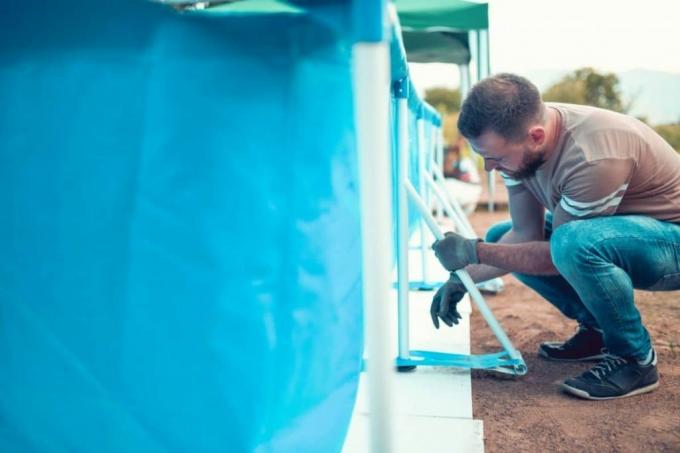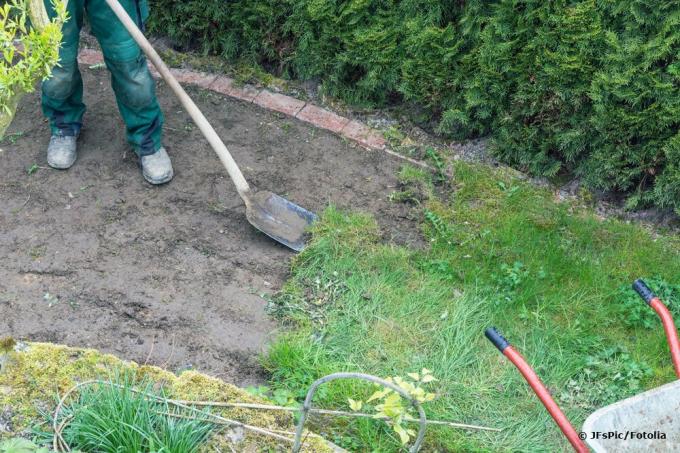
table of contents
- Straight ground is important
- Mark the installation area
- Check the subsurface
- Compensate for the gradient
- Temporary pool installation
- Concrete substructure
- Substructure made of paving stones
- Substructure made of wood
- frequently asked Questions
Having your own pool in the garden is something beautiful. However, in order to have a long bathing fun, the substructure of the swimming pool is crucial. There are various options for a pool substructure. Read for yourself.
In a nutshell
- correct location ensures stability
- a straight surface is important and protects the outer skin of the pool
- compensate for inclines in the event of unevenness
- Protect the ground with a protective mat
Straight ground is important
Before it comes to the pool, some preliminary work must be done. It does not matter whether it is inflatable pools or frame pools with a fixed frame. The correct location is always important so that the pool does not tip over later. In addition, the subsurface plays a decisive role in stability. This must
- horizontally and evenly
- free of knots, weeds and stones
be. Even the smallest stones or roots can damage the outer skin of the pool. It is therefore essential to check the subsurface carefully before setting up the pool.
Note: Every centimeter of a slope already has an impact on the water level. In the worst case scenario, the pool can simply tip over later if it is filled with a large amount. A gradient of 1% is sufficient for this.

Mark the installation area
To check the subsurface for unevenness, the future installation area of the pool must first be marked. The procedure for round pools is as follows:
- Put a pipe in the middle of the surface
- tie a string to it
- The length of the cord must match the radius of the pool
- Run around the pipe with a taut cord
- mark every few steps
- for example using larger stones
In the case of square swimming pools, the length and width of the area are simply measured and marked.
Check the subsurface
The sub-floor can then be checked for unevenness. If a lawn was chosen to set up the pool, the lawn should be mowed briefly. In addition, a straightedge with a spirit level or a spirit level are needed. With these tools it is easy to determine unevenness in the floor:
- Place a spirit level or straightedge on the floor
- measure in one direction first
- then measurement at right angles
- two measurements through the center point for round pools
As soon as there are differences in height of more than 3 cm, it is necessary to straighten the sub-floor, although pools with steel frames can usually still cope with slight unevenness in the floor. However, here too the difference in height should not be more than three centimeters over a length of five meters. A small difference in altitude is acceptable for a short time. Then the pool must not be filled completely, otherwise it would tip over. If the pool remains in one place permanently, a level surface is necessary.
Compensate for the gradient
There are various ways to compensate for the existing slope or individual holes, such as
Fill up with sand
With this method, on the one hand, the pool liner is protected and, on the other hand, unevenness in the ground is leveled out. No great specialist knowledge is required for this:
- Fill in 1 to 2 cm of sand
- Moisten the sand well
- then compact with a garden roller
- alternatively, a full water barrel is also possible
- then peel off with a straightedge or straight board
Joint or quartz sand with a small grain size is well suited for processing here. Another way of smoothing out bumps is that
Removing the sward
This method guarantees that the swimming pool is extremely secure. Before the pool is set up, the sward or top layer of soil is removed using a spade in order to create a straight substructure. The procedure is as follows:

- Cut off the base with a spade
- Choose a little bigger
- then remove and remove smaller turf
- Align the straightedge and check that the floor is flat
- if necessary, remove soil in all directions until the bar is straight
- Compact the soil well with a garden roller, full water barrel or vibrating plate
- Apply weed control
- Choose weed control with a thickness of 150 g / m²
- Place a special pool tarpaulin or floor protection mat on top
- then set up the pool according to the manufacturer's instructions
The weed fleece prevents an increased growth of weeds of all kinds. At the same time, it is possible to use the floor protection mat to protect the subsurface. The plastic bottom material of the pool is also protected against pressure points, which would otherwise lead to permanent damage.
Tip: In pools that are filled with water, a slope can be seen on the water level. In addition, the pool is deformed. He has a light stomach.
Temporary pool installation
For a short time, a few days, the pool can confidently be set up on the lawn. This should be level and horizontal and to protect the ground, a special pool tarpaulin or floor protection mat is also placed underneath. The pool shouldn't find a place here for a long time, because the lawn plants underneath would then not get enough air and light and ultimately start to rot. This can also lead to an unpleasant smell. If the pool is to remain permanently in one place in the garden, it is advisable to build an appropriate substructure made of concrete, concrete slabs, paving stones or wood.

Concrete substructure
A concrete substructure is the most stable form to set up a pool. For the production of the concrete slab, it is best to use ready-made mixes from the hardware store that you can mix yourself. Attention must be paid to the degree of hardness. The decisive factor is the weight of the pool. The work can be carried out by yourself:
- Excavate the base at a depth of 40 cm
- Introduction of a 15 cm high layer of gravel
- compact well with a plate compactor
- Cover the area all around with wooden slats
- Mix concrete
- Distribute evenly over the surface
- The surface must be level
- Allow water standing on the surface to evaporate
- then level the concrete straight off with a straightedge
- Let the concrete harden for two weeks
- then set up the pool
Substructure made of paving stones
Paving stones also form a stable substructure for a pool. However, the surface of the stones should be flat. Alternatively, floor panels can also be used. But they have to be laid correctly:
- suitcase the corresponding area
- Pour in a layer of crushed stone and gravel
- compact well with the vibrating plate
- then apply a layer of chippings and compress
- Put paving stones
- Shake the surface well
- Fill joints with sand
- Lay a protective mat on top of it without folds
The paving stones or concrete slabs should be larger, accordingly the joints are then relatively small, which in turn is good for a high load.
Note: Poured concrete slabs are more durable than paving stones.

Substructure made of wood
Of course, wood in the form of decking or wooden ceilings can also serve as a substructure for a pool. Here, the load-bearing capacity must be taken into account during construction. Furthermore, the wood must be protected from water with a glaze. Set up in front of the pool, a floor protection mat or pool liner must also be laid out here.
frequently asked Questions
It depends on the length of the pool's lifespan. Since the plants will not get any light or air during this time, the surface will definitely turn brown. It is possible that grass plants will recover here and there, but this will take a long time. It is better to re-sow the lawn.
It is quite possible. However, it should be noted that terraces usually have a slight slope so that the water runs away from the house. These have to be balanced. The load-bearing capacity of the terrace must also be checked. A specialist can help with this.
Yes. Styrodur is made from polystyrene. During processing, it is pressed and filled with air. This creates an even and fine surface. The material is pressure-resistant and insensitive to water. It is a good pool mat, but relatively expensive. Here, too, a floor protection mat should be laid out directly under the pool.


